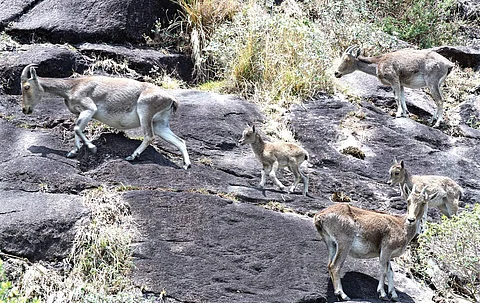

ALAPPUZHA: With its ubiquitous curved horns and bristly mane, the Nilgiri Tahr or ibex is an integral part of the Munnar wildscape, amusing visitors with gravity-defying stunts on steep cliffs. Given its highly endangered status, authorities have always kept tabs on their numbers.
Now there is good news for wildlife enthusiasts. The Nilgiri Tahr population has shown positive growth. Their number has exceeded 1,000 in Rajamala under the Eravikulam National Park, according to the Forest Department’s preliminary census conducted last month. The previous survey in April last year had counted between 940 and 950 ibex.
The preliminary count found nearly 1,050 Tahrs with around 90 newborns in the region, Eravikulam National Park assistant forest conservator S Sandeep told Express. The number of newborns stood at 98 last year.
The park will reopen for tourists on April 11 after it was closed on February 1 because of the gestation period of the ibex. Sandeep said a detailed count will begin at Rajamala on April 20. Kerala Forest Research Institute’s Wildlife Department head E A Jayson said the ibex population has shown an increase because of the Forest Department’s preservation initiatives. Predators, poaching and loss of natural habitat were the reasons for the decline in population, he said.
A survey carried out by Pondicherry University scientists in 2009-10 found poaching had taken its toll on the ibex population. They spotted the Tahr in 14 areas of the Western Ghats, including Neyyar, Ponmudi, Parambikulam, Nelliyampathy, Siruvani and Silent Valley.
The survey spotted 235 Tahrs in various locations except Rajamala. It also detected signs of poaching in most of the locations.
Unregulated tourism is another threat faced by the ibex which features in the red list of the International Union for Conservation of Nature (IUCN). Motorable roads have increased access to the sites bringing in large groups of visitors.
Scientists also found the natural expansion of forests and monoculture plantations led to depletion of grasslands where the ibex roam.